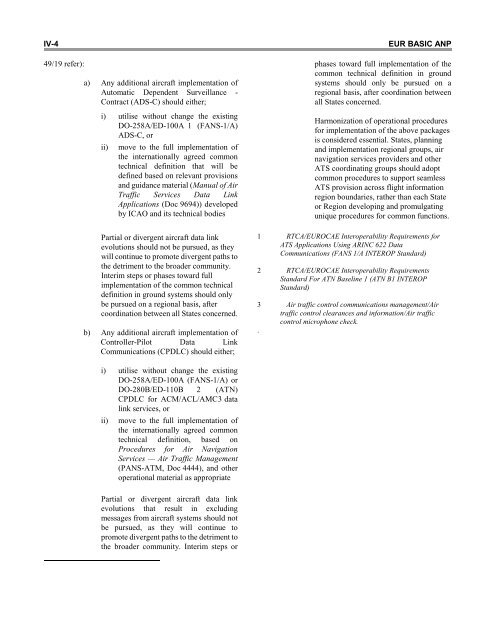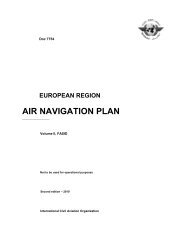7754 Vol 1 Flyleaf - ICAO Public Maps
7754 Vol 1 Flyleaf - ICAO Public Maps
7754 Vol 1 Flyleaf - ICAO Public Maps
You also want an ePaper? Increase the reach of your titles
YUMPU automatically turns print PDFs into web optimized ePapers that Google loves.
IV-4 EUR BASIC ANP<br />
49/19 refer):<br />
a) Any additional aircraft implementation of<br />
Automatic Dependent Surveillance -<br />
Contract (ADS-C) should either;<br />
i) utilise without change the existing<br />
DO-258A/ED-100A 1 (FANS-1/A)<br />
ADS-C, or<br />
ii) move to the full implementation of<br />
the internationally agreed common<br />
technical definition that will be<br />
defined based on relevant provisions<br />
and guidance material (Manual of Air<br />
Traffic Services Data Link<br />
Applications (Doc 9694)) developed<br />
by <strong>ICAO</strong> and its technical bodies<br />
Partial or divergent aircraft data link<br />
evolutions should not be pursued, as they<br />
will continue to promote divergent paths to<br />
the detriment to the broader community.<br />
Interim steps or phases toward full<br />
implementation of the common technical<br />
definition in ground systems should only<br />
be pursued on a regional basis, after<br />
coordination between all States concerned.<br />
b) Any additional aircraft implementation of<br />
Controller-Pilot Data Link<br />
Communications (CPDLC) should either;<br />
i) utilise without change the existing<br />
DO-258A/ED-100A (FANS-1/A) or<br />
DO-280B/ED-110B 2 (ATN)<br />
CPDLC for ACM/ACL/AMC3 data<br />
link services, or<br />
ii) move to the full implementation of<br />
the internationally agreed common<br />
technical definition, based on<br />
Procedures for Air Navigation<br />
Services — Air Traffic Management<br />
(PANS-ATM, Doc 4444), and other<br />
operational material as appropriate<br />
Partial or divergent aircraft data link<br />
evolutions that result in excluding<br />
messages from aircraft systems should not<br />
be pursued, as they will continue to<br />
promote divergent paths to the detriment to<br />
the broader community. Interim steps or<br />
phases toward full implementation of the<br />
common technical definition in ground<br />
systems should only be pursued on a<br />
regional basis, after coordination between<br />
all States concerned.<br />
Harmonization of operational procedures<br />
for implementation of the above packages<br />
is considered essential. States, planning<br />
and implementation regional groups, air<br />
navigation services providers and other<br />
ATS coordinating groups should adopt<br />
common procedures to support seamless<br />
ATS provision across flight information<br />
region boundaries, rather than each State<br />
or Region developing and promulgating<br />
unique procedures for common functions.<br />
1 RTCA/EUROCAE Interoperability Requirements for<br />
ATS Applications Using ARINC 622 Data<br />
Communications (FANS 1/A INTEROP Standard)<br />
2 RTCA/EUROCAE Interoperability Requirements<br />
Standard For ATN Baseline 1 (ATN B1 INTEROP<br />
Standard)<br />
3 Air traffic control communications management/Air<br />
traffic control clearances and information/Air traffic<br />
control microphone check.<br />
.














